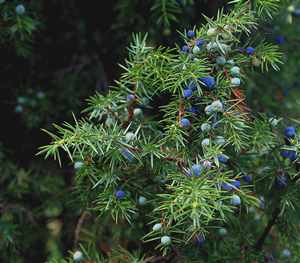Juniper (Juniperus communis)
Main Facts about Juniper

Juniper reaches 6 to 20 feet, depending on locale. Its close, tangled, spreading branches are covered with reddish brown bark, sticky gum, and pointed ½ -inch needles. Males produce yellow flowers and females have green flowers. The females also produce scaly, green, aromatic ¼-inch cones (berries) that turn blue-black during their 2-year maturation. Parts used – berries (miniature female cones).
The genus Juniperus contains more than 70 species of aromatic evergreens. Most are small trees, but some grow to 40 feet.
Aromatic Juniper berries are the flavoring agent in gin that was invented in the 17th century by a Dutch professor of medicine, who was interested in creating a diuretic tincture. The word “gin” comes from the Dutch word for Juniper “geniver”.
During the Middle Ages, Europeans believed that having a Juniper beside the front door kept witches out. Unfortunately, it did not offer complete protection. A witch could still cross the threshold if she correctly guessed the number of needles on the tree.
Juniper’s protective status evolved into the belief that its smoke could stop leprosy and bubonic plague. As recently as during World War II, nurses in France burned Juniper in hospitals for disinfection.
Using Juniper
Juniper is traditionally used as a diuretic, it increases urine production and is recommended as a part of an overall treatment plan for patients with high blood pressure and congestive heart failure.
One herbalist suggests using the herb as a urinary deodorant in cases of chronic incontinence because it gives urine the fragrance of violets.
Since diuretics help relieve the bloated feeling caused by premenstrual fluid retention, Juniper is recommended to treat premenstrual syndrome. Juniper stimulates uterine contractions. Women might try it to help start their periods. Often taken in combination with other diuretic herbs, an infusion of berries is a traditional remedy for arthritis, gout and rheumatism. Native Americans used the herb for this purpose.
Use 1 tsp. of crushed berries per cup of boiling water. Steep for 10 to 20 min. Strain. Drink up to 2 cups a day for no more than 6 weeks. Juniper is also recommended externally as an antiseptic.
Juniper is a remedy for: Arthritis
How to grow Juniper

Females produce immature (green) and mature (blue-black) berries simultaneously. Harvest only mature berries in fall. Dry them in the sun. When dried, they turn a dull black.
| Jujube |
Kañiwa
|